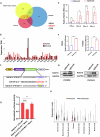MicroRNA-379-5p attenuates cancer stem cells and reduces cisplatin resistance in ovarian cancer by regulating RAD18/Polη axis
- PMID: 40016217
- PMCID: PMC11868536
- DOI: 10.1038/s41419-025-07430-5
MicroRNA-379-5p attenuates cancer stem cells and reduces cisplatin resistance in ovarian cancer by regulating RAD18/Polη axis
Abstract
Ovarian cancer (OC) is an aggressive malignancy of the female reproductive organs, associated with a low 5-year survival rate. Emerging evidence suggests the pivotal role of microRNAs (miRNAs) in regulating chemoresistance and metastasis in OC, primarily through cancer stem cells (CSCs), also known as cancer stem-like cells (CSLCs). Herein, we demonstrate that miR-379-5p is downregulated in several OC cell populations including both cell lines and patient tumor samples. Furthermore, overexpression of miR-379-5p effectively inhibits CSCs and counteracts cisplatin-induced expansion of CSCs. Further mechanistic investigations identify RAD18, a DNA repair protein involved in translesion DNA synthesis (TLS), as a direct target of miR-379-5p. Moreover, a negative correlation between miR-379-5p and RAD18 expression is observed in ovarian CSCs isolated from OC patients. The downregulation of RAD18 inhibits stem-like phenotypes and enhances the sensitivity of ovarian CSCs to cisplatin treatment. Importantly, miR-379-5p-mediated inhibition of RAD18 prevents the repair synthesis in CSCs by promoting the accumulation of DNA damage. In vivo studies further reveal that miR-379-5p enhances DNA damage, which, in turn, inhibits tumor cell proliferation in athymic nude mice. Remarkably, targeting of RAD18 by miR-379-5p prevents monoubiquitination of proliferating cell nuclear antigen (PCNA), resulting in reduced DNA Polymerase η (a TLS polymerase that helps to bypass DNA lesions) recruitment to lesion sites. In the absence of Polη, the persisting DNA lesions cause activation of cell cycle arrest and apoptosis pathway in CSCs. Therefore, our findings unveil a novel mechanism whereby miR-379-5p overexpression curtails CSCs by modulating the RAD18/Polη axis.
© 2025. The Author(s).
Conflict of interest statement
Competing interests: The author declares no competing interests. Ethics approval and consent to participate: All experiments related to patients were performed at CNCI, Kolkata. Before starting the study, the mandatory institutional human ethical clearance was taken (Ref No. CNCI-IEC-40104). Patients were made aware of the study’s objectives, and their written consent was also received. Animal care and related experiments were conducted following institutional guidelines and with the approval of Ohio State University’s Institutional Animal Care and Use Committee.
Figures








References
-
- Arora T, Mullangi S, Vadakekut ES, Lekkala MR. Ovarian cancer. 2023 [cited 2023 Oct 24]. https://pubmed.ncbi.nlm.nih.gov/33620837.
-
- Louka M, Boutou E, Bakou V, Pappa V, Georgoulis A, Stürzbecher HW, et al. DNA damage response/repair in cancer stem cells—potential vs. controversies. In: Chen CC, editor. Advances in DNA repair. Rijeka: IntechOpen; 2015. p. 15. 10.5772/61355.
MeSH terms
Substances
LinkOut - more resources
Full Text Sources
Medical
Research Materials
Miscellaneous

